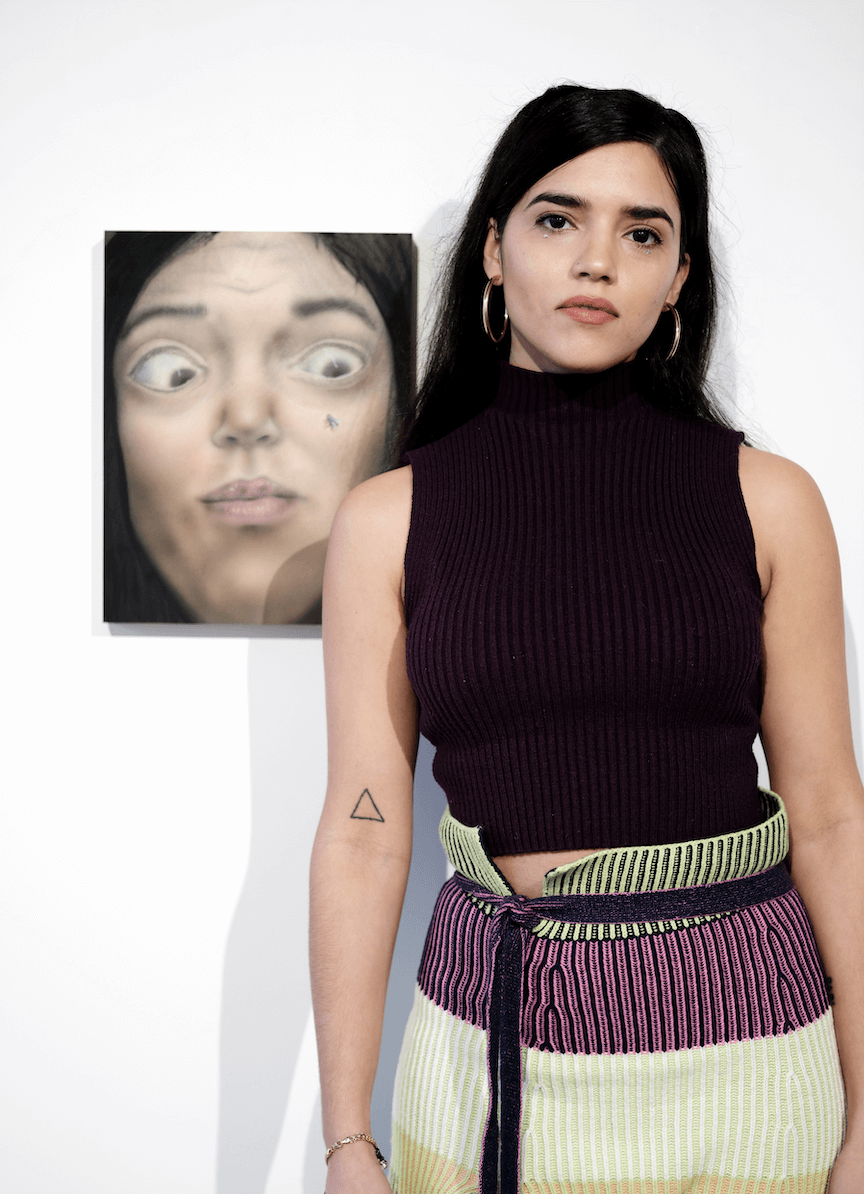
PHOTOGRAPHY SANTIAGO FRANCO SCHICKE @santiagofrancoschicke
TEXT JESPER GUDBERGSEN @yessirjesper
Tell me about your upbringing and how that impacted what you do today?
I was born and raised in Puerto Rico and started making art when I was a child. My parents put me in painting and drawing classes when I was a kid and I picked it up really quickly. At first I enjoyed the approval and validation my parents were giving me and wanted more of that, but then I ended up falling in love with the craft, and becoming better at it. I also found that it was a really helpful way of self-expression and a way to express the parts of myself that I wasn’t comfortable sharing with everyone while growing up.
I was always in church. My parents grew up in the church, my family had their own church and everything, so Christianity was the whole thing in my upbringing. And even though I do still believe in God, I always had a problem with religion itself, and how confining it was. Christianity often puts women second and that clashed with me because I’m a very independent woman. When my parents got divorced I watched my mother being so strong and independent, but at the same time the Bible was telling me that the man is the head of the household, women come second in everything… That’s where my interest in female bodies started arriving, I was around 13 when I first started painting and drawing women. Naked women. My mother hated that I did that, but I loved it so it was a way for me to rebel. I loved expressing myself in different ways, and it was very helpful for me to get to know myself, you know, as a young girl. Of course now, my mother loves it – she loves the bodies that I create.
When your style became harder for your parents to understand, did someone else become your support ?
Even though they didn’t always like what I was making, my parents always encouraged me to keep making art because they saw how much I loved it. And you know, when someone you love is doing something that they love to do – even if you’re not cool with it completely – you want them to do what they love. My parents are my everything and my best friends and have always been supportive in one way or another.
I think the first outside support came when I met my partner when I was 19. He was a gallerist in Puerto Rico and when he saw my work he validated me in new ways, he challenged me to go bigger and to really pursue my craft. He gave me a lot of ideas and ways to push myself. I’m still with him because that type of support and belief in my practice means the world to me. He’s been a very important part of my growth as an artist.
Where did this dedication to art lead you?
Eventually I transferred from a specialized art school in Puerto Rico to Hunter College in New York, which wasn’t even my idea to begin with. My dad was pushing me to leave the island, because he was seeing kids my age getting lost in their way. The island mentality and the influence of living in a beautiful, easy-going place can get the better of young people and he was terrified that I would end up lost like so many others.
It’s interesting to me that he would send you somewhere that many other parents would be afraid of for similar reasons…?
I’m sure my parents were terrified actually. My dad lived in Brooklyn when he was young and he definitely had his doubts about sending his 19-year old daughter off to the city, but they put me up in the dorms where there was a sense of supervision at least.
What happened when you eventually graduated ?
When I graduated I was very eager to figure out what I could do with my degree, because I wasn’t taught anything about the actual business of art in school. Honestly, I just thought that I was gonna be a teacher, that’s what I had in mind. I had a short slew of random jobs – whatever I could get – but always continued working on my craft at night after work. Eventually I got sort of a dream job at MoMa which enabled me to keep investing in my work, buying materials and keep making. It was tough, but it was really the only way I saw things making sense at the time. When the pandemic hit, the museum was closed and I found myself with a lot of time on my hands. I was in good health and I started making a lot of art. I started my instagram and slowly grew my business from there, taking commissions and making art from people’s cats, dogs, portraits and so on. And it kinda grew into my little business from that…
How long did it take for you to make the leap into being a full time artist?
I took the leap into going full time about 9 months into the pandemic. This is what I’d always really wanted, I wanted to be a full time artist, whatever that took. But you know, it’s tough being on your own like that, figuring out marketing, how to promote your work, and how to do business with all these galleries…
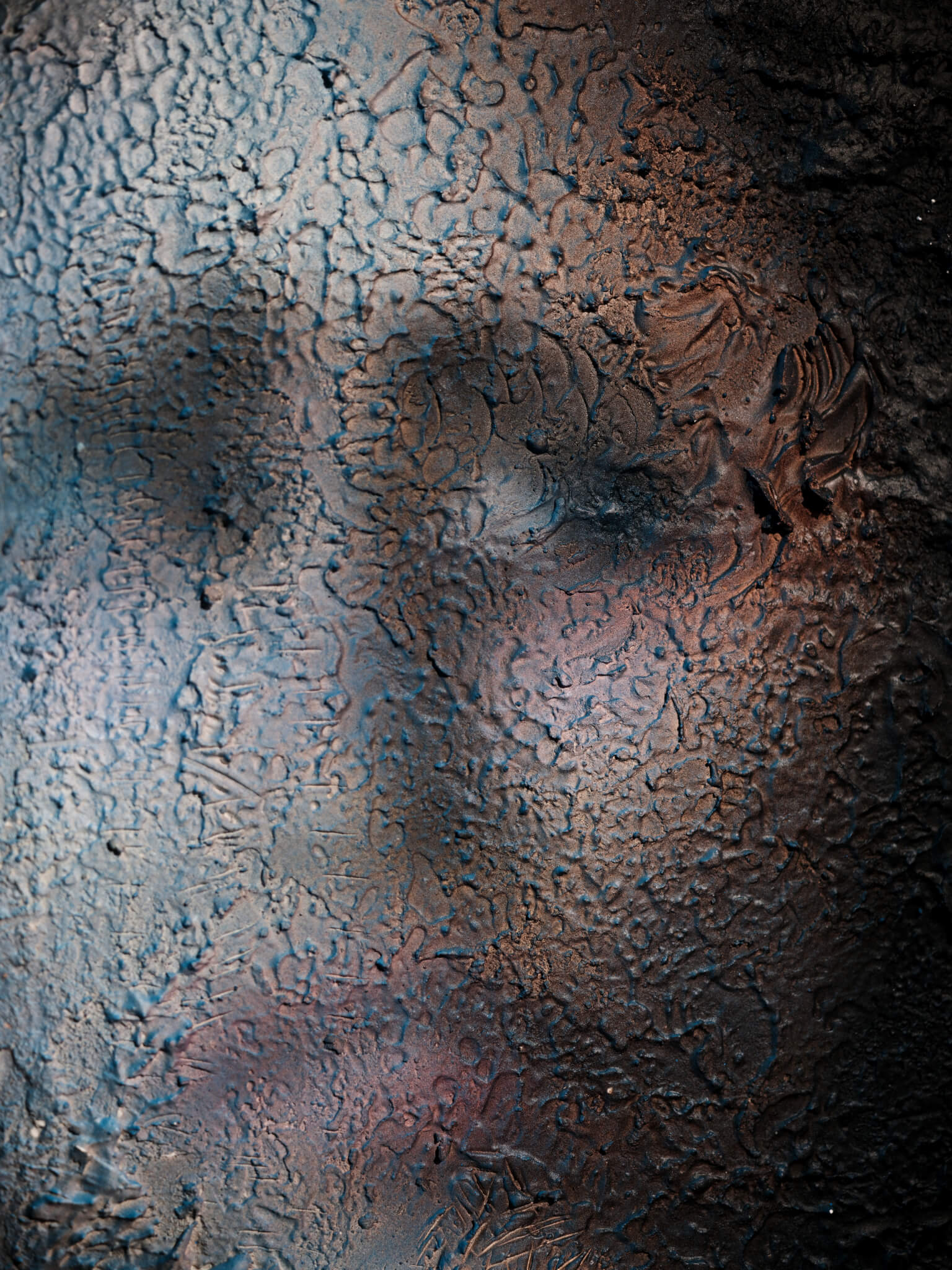
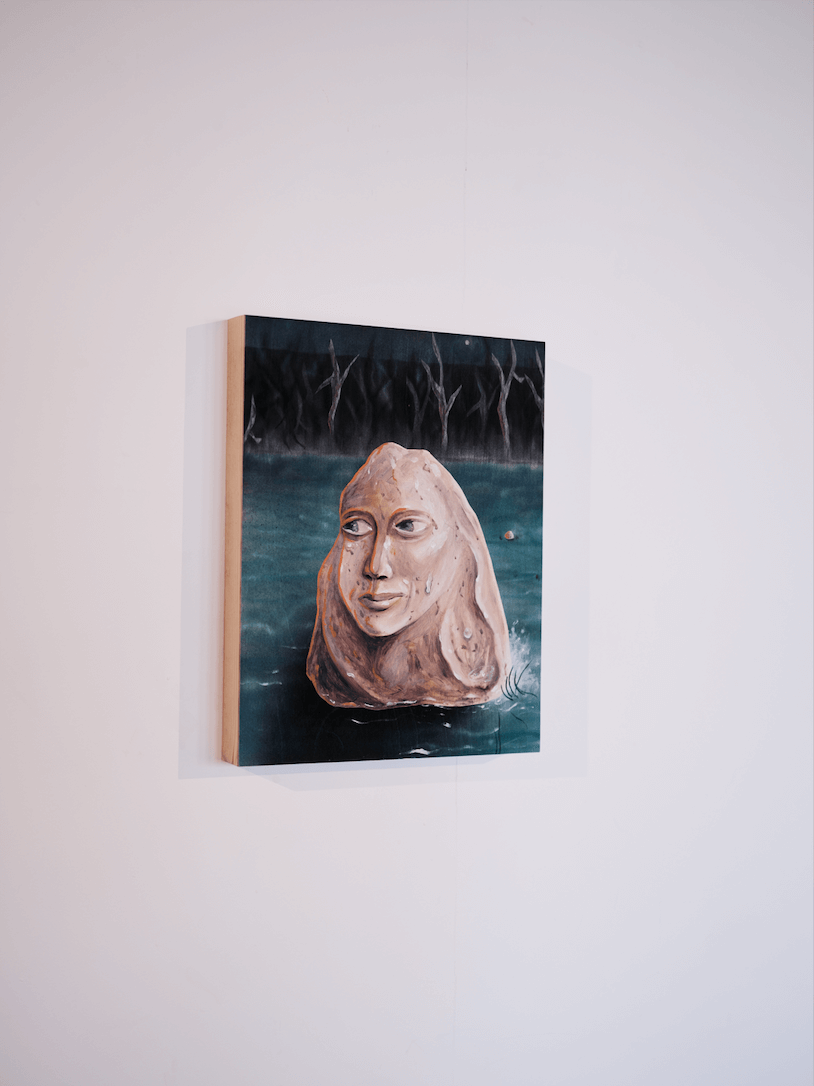
One thing that first caught my attention about you, is how you involve your community in this process and talk about everything so candidly. You quite literally aim to hold their hand and share how you juggle all the responsibilities that come with being an independent artist. When did you decide to bring that aspect into your content?
The fact that nobody was sharing anything about what it was like to be an artist made me think that there must be a lot of artists going through all of these struggles as well. What do you do with a consignment agreement – how do you make an artist statement? You’re supposed to learn so many of these things in school, but I don’t feel like that was taught. And if you don’t have the privilege to go to art school, where the hell do you learn these things? That was my first thought: I know I’m not alone. So I just had to bite the bullet, and put my fears aside and say: “Listen. I’m just gonna record myself, and what I think about all this”. It’s terrifying sometimes, honestly, because I am opening myself to criticism, whatever people want to say about me. But I know that at the end of the day, I’m helping someone out there that might be going through the same thing.
You’re basically creating this sort of guide, or the helping hand that you were looking for yourself…
The art world is so gatekeeping, the people are so protective of the information they’ve learned – as if they came up with it, or as if they invented it on their own? No, somebody gave that to you, you know you learned that from somebody else. Pass it forward!
How would you describe your work to someone who has never seen it?
It’s tough, but I would say, it’s emotional. My art is filled with all types of emotions and a lot of the time, it’s humorous. I enjoy using humor as my coping mechanism. and also exposing that part of myself to the world, because I feel that I don’t always feel comfortable enough to show that side.Through my work I’m able to show the crazy faces I make, the sides of me that no one sees and I like expressing all the parts of myself through my work. It’s all in the attempt to make other people feel seen as well. It’s like a mirror: if I expose myself, and I’m able to be vulnerable enough through my work, I know that is going to be a mirror to someone else.
So it’s a way for me to try to connect. Really, that’s why I’m an artist.
Speaking of themes, you’ve mentioned the humor and female form as themes in your work. Can you elaborate on that?
Yes, let’s talk about the bodies for a second. The female body is where it started. As I continue to grow, I’m able to develop a language for these works and I’m learning to truly understand the subconscious meaning of making these naked bodies. What I’ve gathered is that my mother hated her body when I was a child, and she vocalized that constantly. She would say how she hated her belly, hated her this or that and I started to hate my body too because that’s what I learned. As an adult, I understand that I need to unlearn this and to forgive her for that. I need to learn how to love my body and love who I am, so that’s one of the main reasons why I keep going back to the body. I yearn to love it. I yearn to love my body so I’m trying to use my work as a teacher. I suppose it helps me love myself more. So that’s the bodies. And what else? The faces? The expressions? Well, that’s really part of that intimacy. And a part of who I am that I don’t show to the world a lot, especially on social media, because it’s so curated. I’d rather show it through my work. Facial expressions are something that is part of my family as well, because people in my family are dramatic as hell. I’m telling you: they’re funny, they make faces, and they make voices. I enjoy that comedy and for me it’s about showing that part of myself. It’s okay to be silly. A lot of my work revolves around me, understanding myself and me feeling compassion and love for who I am, truly my authentic self.A lot of the time we fight with the voice in our heads telling us not to be like that, it’s not normal… “I don’t want to feel like the weird girl”, you know? But through my work I’m able to embrace the weird girl, and that’s why I keep coming back to it. I can’t run away from it because I feel understood.
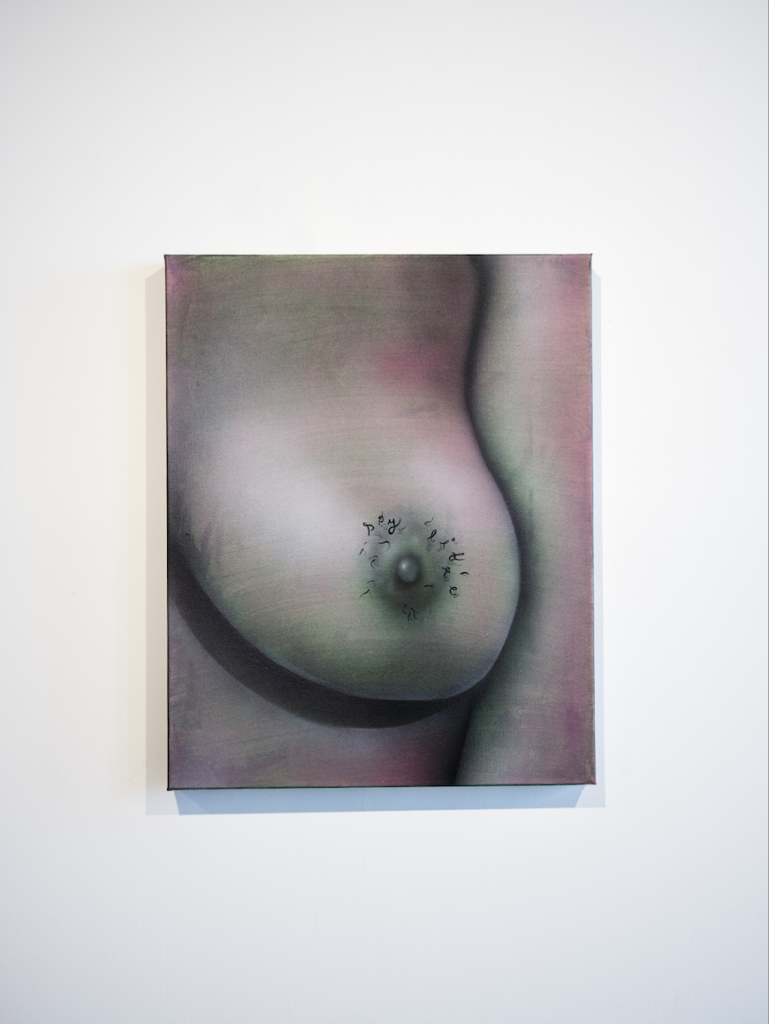
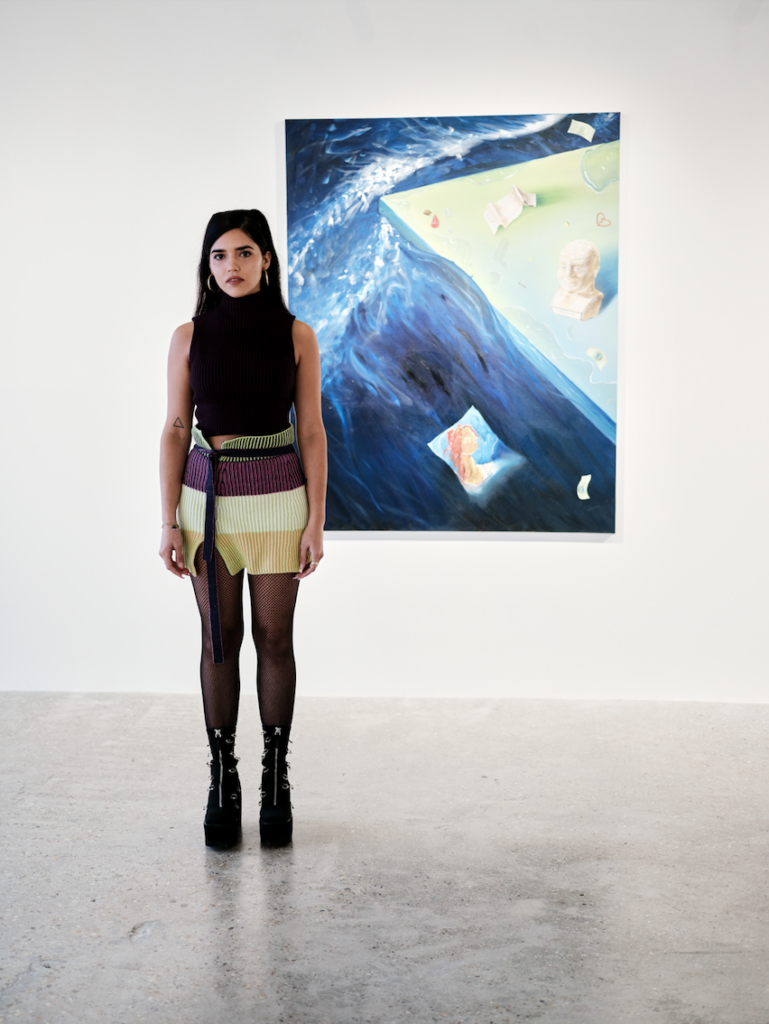
It feels to me like in fine art, there can be a fear of not being serious enough, there’s often a lack of humor. Have you ever experienced any kind of resistance because of this?
Yes, and I actually had a conversation with an artist yesterday, who does these very beautiful abstract and technical paintings. I showed her my work and her reaction was very much ‘oh that’s very edgy, I wouldn’t put that on my wall, but I could see why someone could maybe like that?” This is how a lot older people think when they see my work. Who would put a painting of somebody licking another person’s foot on their wall? But it makes you feel something, you know. You look at it. What the hell is going on? It awakens something in you, just like an abstract painting could awake something in you. This is just the way that I need to express myself. A lot of people don’t get it right now, but they will eventually.
Can you pinpoint a moment where you feel like you found your expression, or your voice, so to speak?
I feel like I started finding my voice when I started writing about my work. It was difficult for me to understand why I was making all these random paintings. When you look at my work, you can tell that there’s a certain style, but I am not the type of artist to repeat myself, or make the same piece 20 times over. When I make a painting, I’m making that painting, I’m not thinking about all the others that I did, or the others that I’m going to do. I’m just thinking about what the story is in this particular piece. When I started writing about my work, I started seeing why I was making this painting and how it relates to this other one… I started seeing a lot of similarities and things that keep coming up. That’s how I understood the faces, how I understood why I was making bodies, why I was making feet and eyes. It was the only way for me to explain my work to others. It all starts with writing, because you have to know what you’re saying.
Did finding a better understanding of your work ever hinder you from moving on to the next piece? I imagine it could create some kind of block, even the grid of social media impacting how you always see one work in relation to the others?
One of the first huge blocks that I had as an artist was when I felt that I needed to have an artistic style in order to succeed in the art world. This belief is not only wrong, it blocks a lot of artists and I’ve always been very against having a ‘style’, or perfectly pushing myself to have a style. I understand that style is something that comes with experience, an authentic style that you cannot shake off only comes with experience. You could make an artistic decision to only paint in the color pink for example, and even though you can be very successful doing that, you are also closing the door to so many other possibilities that you could be learning from. You can explore, you can master so many things. I always remind myself NOT to put limits on my art; I’m a multi-disciplinary artist, I can do performance, I can do painting, drawings, whatever. You can do whatever the hell you want, and no, don’t let anyone tell you otherwise.
On social media and on your blog, you’ve shared your experience as a young female artist of color in the art world. Can you share some of your current thoughts on this with us?
In my experience, because I am young and I look young – that in itself makes people assume that I don’t know enough about the business in particular. I have to give credit to my father, because my dad always told me from a young age that I needed to be independent, that I needed to know how to manage money and manage my own business. He always told me that I don’t need anyone else. In entering the art world, managing myself and my career, I’ve had to deal with a lot of men that want to control anything they can get their hands on. That’s been difficult. So many men outright tell me what to do, because they assume that I don’t know, but I try not to take it to heart – I can’t lose sleep over those things, I have to keep doing my thing.
Being a woman is another reason why I have been underestimated. What I’ve learned is that I’m very good at listening to advice. If I am unsure of something, I call my father, lawyers and I call investors – I call people that know the business, so I can learn and move on. I’m very aware that I’m young, but I’m set on not being naive because I want to learn, you know, I want to grow. Yes, on the surface I embody these facets that create a bias against me; I’m a young latina woman. But honestly, I understand that I am a very privileged person, I have everything that I need. So many artists try with everything they’ve got, are brilliant and still never achieve living off their work, so I am aware that being a full time artist in itself is a privilege. This question reminded me how the other day, I was painting a rug in the park and a random guy comes up to me, loves the piece I am making, but when he asked me for my name, he said I would never make it because my name was too long, too foreign and too hard to remember…
Ha! That actually leads me to my next question beautifully – would you say that living and working in New York influences your work?
I don’t think about that consciously, but I feel that a lot of people I see are sad. New York is filled with a lot of anxious people, people that aren’t grounded or present really in their life. A lot of us are just going through some shit, you know? You don’t see that in the perfect online world, but I see it when I walk around. You cannot lie when you are walking around and you’re in your head, your face is showing whatever it is going on in your head – you’re scared, or you’re concerned – people show that in their face. I see that a lot and that gives me a clue: if I put that in a piece of art, people are going to see themselves in some way. So in that sense the city does influence me a lot.
It’s present in your work; although your pieces encapsulate humor, it’s not necessarily always a “happy” humor, right? So when you’re going through some shit, do you feel like there are peers in the art world you can lean on?
I do have my chosen few that I like, artists that I trust, and we support one another. When we’re talking about our accomplishments, we celebrate each other, and there’s no jealousy or pettiness within my group. I selected those people specifically, because they’re not intimidated by my success, and I’m not by theirs.
I only say that because I’ve seen the other side of that too many times, from people on all levels of success in the art world. I am a very good face reader and I see the fake smiles when they’re around me, even if they’re way more accomplished than I am. Like, bro, is it truly impossible for you to be happy for another person? Do you live in constant comparison? I don’t get it. All of this, instead of uplifting each other… It’s so hard out here for artists to make friends because many artists feel like there’s just not a piece of the pie for everyone. That’s not true man, everybody’s in their own lane and there’s a lot of people out there with money that collect me, collect them and collect everyone you know… Competitiveness is a big issue and I’ve lost friends because of it. I hate that it’s like that but I need support around me and if I don’t have it, you’re not going to be in my life, period.
You mentioned that you were brought up with religion quite close to you in your childhood. Is there a spiritual place that you go to for guidance still?
I get my spiritual needs met in nature and the beach is the ultimate place for me, nothing compares to the beach. I’ve had to adapt to New York though, so whenever I go to a forest or a lake, I feel it. The cute human bodies are so attracted to bodies of water that we cannot feel bad for too long when we’re next to them. Nature has a beautiful way of grounding me and making me feel little, in a very beautiful way. It reminds me that my problems are not as big as I’m making them. All of what I carry, I don’t need to carry it anymore. When I’m in nature, I’m able to connect to a higher self. That’s my main thing. Reading books really ground me as well. I just read the book “Think Like a Monk” by Jay Shetty, which is incredible. It’s helped me get in touch with my inner self, learn about forgiveness and taught me how to treat others. Everything that we do inwards is really so that we can treat others better. Reading spiritual books helps me out.
Where do you find beauty?
Beauty is the energy that you put out into the world. I feel like a lot of beautiful people can be boring because they’re not interested in finding out what is underneath all of that. I think that the most profound beauty is that of someone that can make you feel special when you’re talking to them, you know, they make you feel like you are interesting; “I have things to say, I’m worth being listened to ‘. If you can make somebody feel this when they’re with you, I think that makes you beautiful. They will remember you. It doesn’t matter what you look like, if you can do that, that’s power.
You’re between your first solo show abroad in London earlier this year and have an upcoming solo show in Los Angeles just a few days after this comes out. Can you tell me a few things about these two shows and what they mean to you?
The London show is called “Distraida” (Distracted) and I made that body of work when I had just gotten back from a month-long residency in Spain, where I read a lot of spiritual books. I was with my mom, which enabled me to process a lot of things, and I was also able to meditate a lot, so I felt very grounded and present while I was there. When I came back to New York, I felt like I lost a lot of that presence, it was leaving me fast. I felt really sad coming back here because I worked so hard to be in a state of mind where nothing fazed me. All of a sudden, I was back in the city, where people are upset and acting crazy. It started to create a lot of noise in my head. Jumping back on social media didn’t help either, so my distracted mind made pieces that reflect that in a way. You can feel like there’s sort of stress, or uneasiness about those pieces
My work is all about processing whatever I’m going through, so when I started working on the LA show at Nicodim, I was able to process that distracted feeling from the Guts show in London. I went to look within. Let’s appreciate what I have in front of me. So I started blending this into my spaces, seeing how I could meditate in my home and how I can be okay in there – not always focusing on the things I am missing or wishing I could go back.
My show in LA is called “Eso Pasa”, which means both ‘that happens’ and ‘that passes’. To me this means – “hey, chill out, it’s alright. Whatever you went through or are going through is all temporary, you’ll be able to get through it. There’s a lot of self compassion and self forgiveness in the LA show, something we wouldn’t necessarily see in the London show. I’m very happy with the LA pieces. It’s been a while since I’ve been so proud of a body of work. These pieces are meditative. They are very intimate. They are weird as hell, the compositions are random. I took so much risk this time, for instance in not using airbrush… I just took my time with these works and I’m very proud of them.
How lucky to have a second lined up shortly after, giving you an outlet for processing your feelings so quickly! What was it like to have your mom with you during the residency?
I don’t ever want to do residencies on my own. I don’t want to go to sleep alone and I want to enjoy my nights as well, I want to enjoy my time. I can be in the studio for hours alone and I love being by myself, but I want my loved ones next to me, so I decided to bring my mom to this one. We had our fights, but also lots of bonding moments. It was just beautiful – I’m closer with my mom than I’ve ever been in my entire life.
Where do you see yourself going next, what’s the goal that you’re hoping to achieve in the foreseeable future?
What comes to mind in terms of my practice is that I want to create a book that’s not only about my works, but it also has a lot of writing related to my work and my practice. Writings that can help people and give insight to my work, but also offer a glimpse into what it is like to be an artist. This is a career goal for me. On a personal level, to have a bigger home is a goal for me. I live in a small space! I had to reconfigure the layout of my apartment, so that I am now working in the bedroom and my bed is in the living room. For a while, I was painting with an airbrush right next to my bed and it wasn’t sustainable in the long run, so for me, my partner and my dog, I would love to have more space in the future. Maybe even some grass for my dog?
| Cookie | Duration | Description |
|---|---|---|
| cookielawinfo-checkbox-analytics | 11 months | This cookie is set by GDPR Cookie Consent plugin. The cookie is used to store the user consent for the cookies in the category "Analytics". |
| cookielawinfo-checkbox-functional | 11 months | The cookie is set by GDPR cookie consent to record the user consent for the cookies in the category "Functional". |
| cookielawinfo-checkbox-necessary | 11 months | This cookie is set by GDPR Cookie Consent plugin. The cookies is used to store the user consent for the cookies in the category "Necessary". |
| cookielawinfo-checkbox-others | 11 months | This cookie is set by GDPR Cookie Consent plugin. The cookie is used to store the user consent for the cookies in the category "Other. |
| cookielawinfo-checkbox-performance | 11 months | This cookie is set by GDPR Cookie Consent plugin. The cookie is used to store the user consent for the cookies in the category "Performance". |
| viewed_cookie_policy | 11 months | The cookie is set by the GDPR Cookie Consent plugin and is used to store whether or not user has consented to the use of cookies. It does not store any personal data. |